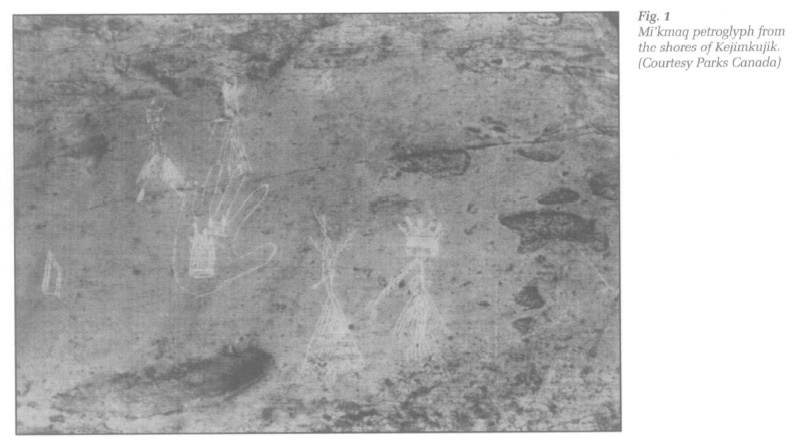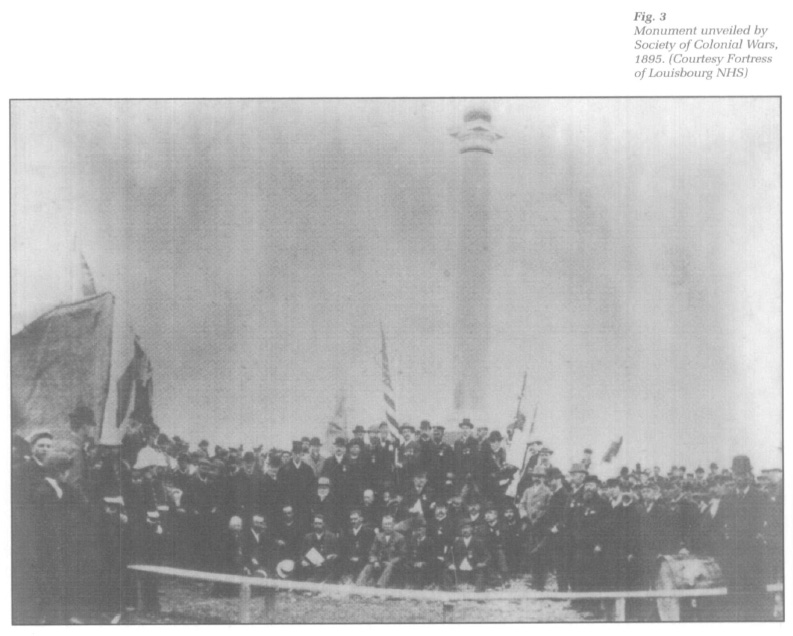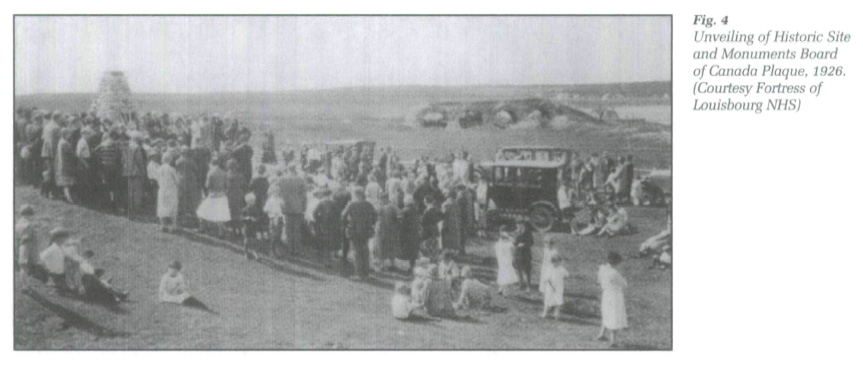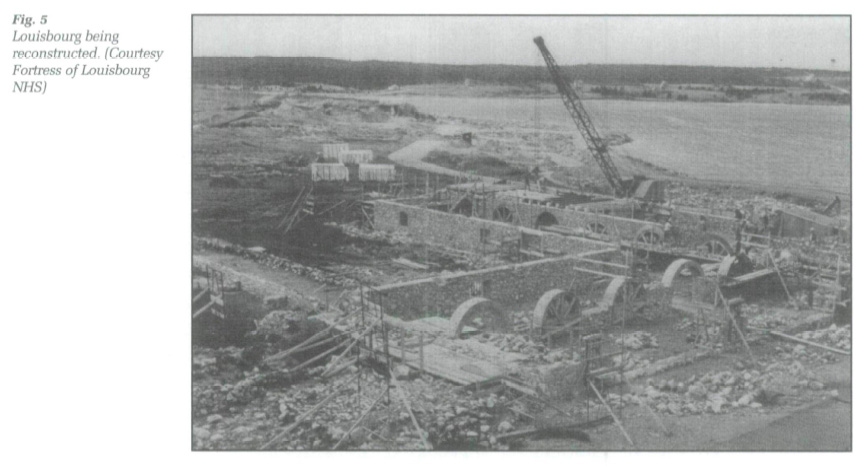Articles
Past/Present/Future:
Marking Louisbourg
Abstract
The human impetus to mark—to leave a sign of one's passage — runs deeply, in all time periods and in all cultures. The focus in this paper is on Louisbourg, one-time French colonial stronghold and current Canadian national historic site. The first efforts at Louisbourg were forward-looking initiatives made in the eighteenth century. The late nineteenth and early twentieth centuries witnessed the development of a reflective type of commemoration. The last four decades of the twentieth century ushered in a massive project to literally re-create a significant portion of the original French town. The thread running through the three centuries is the human need to mark what we are doing, what we have done, and what we will do.
Résumé
L'impulsion humaine de marquer — de laisser une trace de son passage — s'enracine dans toutes les époques et toutes les cultures. Cet article porte sur Louisbourg, forteresse de la colonie française à une certaine époque et aujourd'hui lieu historique national du Canada. Les premiers jalons posés à Louisbourg ont été des initiatives axées sur l'avenir, réalisées au XVIIIe siècle. À la fin du XIXe siècle et au début du XXe, on a assisté à l'avènement d'un type de commémoration fondé sur la réflexion. Les quatre dernières décennies du XXe siècle ont marqué le début d'un grande entreprise visant littéralement à recréer une partie importante de la ville française dans son état original. Le fil conducteur de ces trois siècles est le besoin humain de laisser des marques de ce que nous faisons, de ce que nous avons fait et de ce que nous ferons.
1 Human beings are apparently compelled to mark their passage — both through life and in whatever surroundings they find themselves. The impetus to leave a trace runs deeply, a conscious act springing from an unconscious instinct. There are countless ways in which we satisfy the urge. Words and gestures, shelters and tools, architecture and monuments: examples spring to mind from around the globe and across the span of time.
2 Marking initiatives differ greatly in scale and kind and use a variety of materials. In the sense in which we are using the term "marks," they range from the paintings in the Grotte de Lascaux to the pyramids of Egypt. Or within the Canadian context, from Mi'kmaq petroglyphs on the shores of Kejimkujik to the towering bank highrises of Bay Street. Common to all is an underlying urge to impress, to inspire, and to leave a trace.
3 Objects and structures that have a marking quality are those that go beyond purely functional uses. At least part of their raison d'être — and in some cases it is the primary objective — is to make a deliberate intellectual or emotional impact on those who behold them. Such a characterization includes everything from street grafitti to commissioned architecture to the earnest plaques put up by local heritage societies. Despite the breadth, let us accept the definition for the moment to see if marking is a concept that helps illuminate human behaviour.
4 Of the countless places on the Canadian landscape that have been marked, the focus in this paper is on a place that has been at the centre of my personal research interests for over twenty years. This is the one-time French colonial stronghold and current Canadian national historic site at Louisbourg. Nearly three centuries have elapsed since the harbour was settled in 1713. Over that period, individuals and groups from differing backgrounds and interests have marked the place in innumerable ways. The first efforts in that regard were forward-looking initiatives made in the eighteenth century. They were succeeded in the late nineteenth and early twentieth centuries by a reflective type of commemoration. Meanwhile, the last four decades of the twentieth century witnessed a massive project to literally re-create a significant portion of the original eighteenth-century French town. The motivation for the most recent effort was to rebuild the past in order to inspire present and future generations. The variations in marking across three centuries at Louisbourg are eye-opening. The common thread knitting them together is that they reflect the deep-seated human need to mark what we are doing, what we have done, and what we will do.
 Display large image of Figure 1
Display large image of Figure 1Looking Forward: The French Make Their Marks
5 The French marked their venture at Louisbourg in numerous ways, more or less continuously over its life span. Formal, ritualized affirmations of their occupation of Cape Breton Island, which up until 1713 had been the almost exclusive homeland of the Mi'kmaq,1 ranged from the simple to the elaborate.
6 The first and easiest change they made took place on maps and in speech, when the French replaced most of the place names. Designations given to particular harbours by Portuguese, Spanish or English mariners were swept away, as were most of the even older Mi'kmaq terms. Even some of the old French names, such as Saint-Pierre and Sainte-Anne, which were associated with settlements established during the seventeenth century, were eliminated.2 Many of the new names that were adopted had "royal" associations. The island became lie Royale, the major settlements were called Port Dauphin, Port Toulouse, Port d'Orléans, and Louisbourg. The same pattern continued within Louisbourg itself. Its fortifications and its streets were named after either the royal family or prominent dignitaries (Bastion du Roi, Bastion de la Reine, Porte de Maurepas, rue Royale, rue Dauphine, rue d'Orléans, rue Toulouse, etc.).3 The relative absence of settlements or features named after saints is striking. It set Louisbourg apart from most of the other settlements in New France. Île Royale was characterized by a secular atmosphere more than a devotional one.4
7 The names adopted for communities, streets and other features on île Royale represented a conscious attempt by the French to achieve inter-related objectives: first, to clear the slate on the past, which was characterized by unsuccessful colonizing ventures; and second, to set a tone for a promising future. The colony was a royal initiative and the new designations made that clear.5 The name changes had unmistakeable political-cultural content in that they helped set an atmosphere in the colony that was supportive of the monarchy and the hierarchical social values that institution represented.
8 Beginning in 1720, the French accelerated their attempts to mark the colonial endeavour on which they were embarked. They were building a colony as they went along and they wanted to mark each achievement as it occurred. Professor André Sanfaçon of Université Laval aptly observes: "Jamais les fondateurs ne veulent passer incognito: marquer pour être remarqué."6
9 At Louisbourg the French began by minting commemorative medals that they buried in the foundations of the principal structures in the town.7 Over the course of the next two decades Louisbourg witnessed many similar marking initiatives. Plaques of black marble, or wood painted to look like black marble, always with gilded Latin inscriptions, were placed above the entrances to the walled town. The use of Latin inscriptions was commonplace in France and its colonies. The ancient Roman language was preferred because of the appeal that the Roman era and classicism had for the elite in French society. Latin inscriptions meant the messages would be understood by relatively few citizens, which was part of the appeal. Comprehension of a few words of Latin was a sign of sophistication and differentiation. As such, it was yet another symbol of the hierarchical ordering of society.8
10 Accompanying several of the Latin plaques were the Bourbon coat of arms cut in limestone. The cut-stone representations of the heraldic devices reminded onlookers that they were entering or exiting a place under the jurisdiction of the French king (much as today's citizens are reminded of their governments by omnipresent flags and wordmarks). There is no doubt that plaques, coats of arms and related iconography were taken seriously at Louisbourg. When in 1721 the Récollets tried to place a copper plaque in the foundation of the parish church that was being laid at the king's expense in Block 3, the local royal officials had the construction stopped. The plaque was withdrawn and two of the king's medals were placed in the foundations instead, making it clear who was paying for the construction. Over a decade later the secular officials ordered removed a sign that the Frères de la Charité had put up over the main entrance to the hospital. The sign bore the motto of the religious order, which gave the erroneous impression that the building belonged to the religious order.9 That could not be tolerated.
11 Though Louisbourg was well marked by names, plaques and coats of arms paying hommage to the king, there were still other devices to proclaim the royal presence in the colony. Virtually every building or other structure erected at royal expense was crowned with a metal or stone fleur-de-lis. The lis made its greatest showing in Block 1 where there was a concentration of government buildings. Yet another marker was flags. Large white flags flew from masts around the harbour, conveying the message that Louisbourg and île Royale were under the French king.10 There was even a proposal to erect a statue of Louis XV along the busy quay in Louisbourg11 but the project was not implemented.
12 None of the plaques and ornamentation mentioned above were commemorations in the sense of being put up in remembrance of past achievements. Yet commemorations they were, of a present and forward-looking kind. Collectively they represented a self-conscious assertion that the monarch was looking after the colony and advancements were being made in the form of a building, gate, or lighthouse. The overall effect of putting up so many features with "monumental" qualities was to reinforce the idea that Louisbourg owed much to the king. All those who lived in the town, and visitors as well, must have been impressed by a place being built with such solidity. There, on the edge of a rugged tree-lined coast, was a European-style ville fortifiée striving for permanence. That the place did not fulfill its promise had nothing to do with monumental qualities but with the overwhelming military and naval forces brought to bear against it.
Looking Backward: Victors and Descendants Celebrate
13 The conquests of Louisbourg — by the New Englanders in 1745 and the British in 1758 — gave rise to a new round of commemorative initiatives. As the French had done, one of the first forms of marking was in the sphere of name changes. Many communities around Cape Breton Island were given new designations; so too were the streets within Louisbourg.12 Like the French before them, the British struck a number of commemorative medals. Theirs were to mark the capture of the Cape Breton stronghold.13 Most were produced immediately after the military victory in 1758 but there was another minted in the United States in 1895.14
14 While medals enjoyed a certain vogue, they could not make a lasting impression at the actual location of the victory. Permanent memorials were required for that. The British took the first steps in that direction soon after their 1758 siege victory. Circa 1767, as a decade of post-conquest occupation was drawing to a close, some of the British officers in garrison at Louisbourg erected a monument to their accomplishment. They arranged a pile of the derelict, French-era cut-stones, presumably vertically, then polished them and added an inscription. The memorial was, in the words of its initiator, Samuel Holland, "in the Rustick taste, that the Injurys of Time can make but little impression on it."15 Ah, the wishful thinking of monument builders. The 1767 pile of stones would not enjoy even the lifespan that the French markings had had in the preceding decades. There is absolutely no trace or mention of it after 1767. The polished, inscribed stones must have been carted off by someone looking for a secure foundation to a building in Sydney or Halifax.16
 Display large image of Figure 3
Display large image of Figure 315 Over a century was to pass before more commemorative marks would be left on the Louisbourg landscape.17 Sheep and cattle left their droppings, and subsistence fishers and farmers erected homes and fences, but no more monuments would there be until 1895. Then came an American historical society, the Society of Colonial Wars, that put up a 26-foot high column in the area of the King's Bastion. It was the same general area where, 175 years earlier, the French had buried their foundation medals and put up a black marble plaque and limestone coat of arms. The inscription on the base of the column, "To Our Heroic Dead," summed up the reflective, patriotic, and romantic inspiration of the memorial.
16 A few Canadian Parliamentarians were offended that a private society from the United States was able to erect monuments to American victories on Canadian soil. Prime Minister Mackenzie Bowles assured them there was nothing to be done about it. And indeed, that was the case. There was a National Parks Act (1885) but there was no federal legislation at the time to deal with historical issues or sites. That is not to say there was no interest among the Canadian public in heritage plaquing and monument raising. On the contrary, nineteenth-century Canada witnessed dozens of private commemorative initiatives, especially to the War of 1812, the Boer War, and Queen Victoria.18 Those memorials, like their predecessors at Louisbourg, were motivated by essentially the same underlying desire to impress onlookers and to promote a particular set of political, social and cultural values.
Backward and Forward: Education and Economics
17 The twentieth century in Canada was characterized by a gradual yet steadily growing increase in marking activity by all levels of government. On the surface such commemorations differed from those that came earlier in that they were not put forth as initiatives undertaken to promote any particular group or ideology. The self-proclaimed aim of most agencies involved in heritage commemoration was the supposedly value-free one of educating citizens about the history of their country or community. Nonetheless, in some settings more than others, there was an undeniable political, social and cultural dimension involved in putting up markers. Some groups and individuals found their history commemorated sooner, more often, and more lavishly than other groups and individuals. As the century wore on, the arena of historical commemoration became a battleground when long excluded groups sought to be included.
18 Another aspect of historic site marking in the twentieth century was the economic spin-off, real or imagined. The steady growth in tourism throughout the century led many agencies, communities and organizations to promote their historical landmarks and associations as a way to attract tourists and their dollars. By the end of the twentieth century, in some settings, the situation was comparable to that which existed in eighteenth-century Louisbourg, with prominent reminders of a governmental presence.
19 In the particular sphere of historic site designation, the federal government began to put together an approach in 1919 when it established an arms-length committee to advise on historic site designations.19 The first legislative action involving Louisbourg, however, was taken by a provincial, not the federal, government. It was an essentially meaningless act passed by the Nova Scotia government in 1906 to incorporate "the French Fortress and Old Burying Ground at Louisburg as an Historical Monument of the Dominion of Canada and as a Public Work."20 The legislation was beyond the competency of the provincial government. That it was passed at all was because of lobbying by a private society that was pushing for commemorative action at the ruins of the French fortress. The society wanted a stabilization program and hoped to see the burial grounds of the combatants enhanced. A masonry tower was proposed, within which there would be exhibits, a museum and "underground Mortuary Chambers to contain the relics of the dead found on the site and ... for the remains of the Canadian heroes of the future."21 The links between past, present and future at selected historic sites were being made clear. The area where the Louisbourg memorial tower was to be erected—though it never was — was the same general area that had been marked in 1720 by the French, in 1767 by the British and in 1895 by the Americans. It was the hill of the King's Bastion, the foremost height of land within the fortress.
20 Two decades after the tower proposal, the King's Bastion received its first Government of Canada monument, or rather monuments. During the 1920s, four separate plaques were put up around the ruins. More memorials — another plaque by the federal government and several others by private organizations whose predecessors or ancestors had links with the place — were added to the commemorative inventory during the 1930s. The most elaborate marking measure, as well as the most educational, was a museum erected in 1935-36.22
 Display large image of Figure 4
Display large image of Figure 421 For a quarter century the commemoration of Louisbourg stood relatively still. Then in 1960-61 there was a leap of unprecedented proportions, one that completely transformed the historic site. The transformation began when a royal commission on the Canadian coal industry urged that the federal government undertake a "symbolic reconstruction" of the French fortified town that had vanished two centuries earlier.23
22 The reasoning went something like this: Cape Breton Island has an unemployment problem. Yet the place has scenic beauty and a colourful history. Tourists like scenery and historic sites and spend money travelling to see them. If one could attract enough tourists, there would be a hospitality industry; people would have jobs. But you need something substantial to draw people and their wallets. Louisbourg could be the answer. If you reconstructed something like a Canadian Williamsburg then you would have a tourist magnet. People would be put to work during the building phase; others would have jobs when the project was completed. The direct and ripple effects in the Cape Breton economy would be substantial.
23 And so it came to be. About one-fifth of the original French walled town was rebuilt: about fifty buildings and over a kilometre of fortifications. Thanks to a substantial budget for research, reconstruction, refurnishing and costuming, an impressive section of the mid-eighteenth-century ville fortifiée was re-created.
24 The Fortress of Louisbourg National Historic Site (NHS) has largely lived up to the mixed bag of expectations. It aims to commemorate an important place and era in Canadian colonial history; it aspires to educate the people who visit (and many who cannot, via outreach publications, films, the Internet and other media); and it seeks to have a positive economic impact on the region.
25 Yet make no mistake. Today's Fortress of Louisbourg is a marking measure like all those that preceded it. Its creation was motivated by the same sort of desire to impress onlookers and to promote a particular set of values. The values being promoted were not those of the era of Louis XV, when hierarchical values and the Bourbon dynasty were at the forefront; nor those of the memorialists of the late nineteenth and early twentieth centuries, who emphasized Louisbourg as a battlefield. Rather, the values were those that were thought to suit a bilingual, bicultural country that at the time (1960s and 1970s) was just beginning its second century of existence. The emphasis was therefore not on the one-time Anglo-French conflict but on how lives were lived out in a thriving peacetime eighteenth-century community. Along with that shift in emphasis, Louisbourg also witnessed the addition of the economics of tourism. Marking, to a degree, became marketing. At Louisbourg, as elsewhere across North America, the commemoration of eighteenth-century events served both to mark the past occurrences and equally to attract tourists.
 Display large image of Figure 5
Display large image of Figure 526 The future is unknown but to judge from the commemorative metamorphoses Louisbourg has undergone in the past two and a half centuries, there are likely to be fresh marking initiatives in the future.
